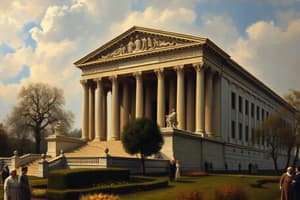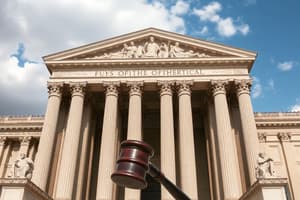Podcast
Questions and Answers
Which Supreme Court case established the exclusionary rule, preventing illegally obtained evidence from being used in federal cases?
Which Supreme Court case established the exclusionary rule, preventing illegally obtained evidence from being used in federal cases?
- Gideon v. Wainwright
- Mapp v. Ohio
- Miranda v. Arizona
- Weeks v. US (correct)
Schenck v. US (1919) established that freedom of speech is absolute, even if it presents a clear and present danger.
Schenck v. US (1919) established that freedom of speech is absolute, even if it presents a clear and present danger.
False (B)
In Brown v. Board of Education (1954), what previous Supreme Court case was overturned?
In Brown v. Board of Education (1954), what previous Supreme Court case was overturned?
Plessy v. Ferguson
The Supreme Court case of _______ v. Ohio_ (1961) extended the exclusionary rule to state cases.
The Supreme Court case of _______ v. Ohio_ (1961) extended the exclusionary rule to state cases.
Match the Supreme Court case with the constitutional principle it addresses:
Match the Supreme Court case with the constitutional principle it addresses:
Which Supreme Court case established that suspects must be informed of their constitutional rights, including the right to remain silent and the right to an attorney?
Which Supreme Court case established that suspects must be informed of their constitutional rights, including the right to remain silent and the right to an attorney?
Terry v. Ohio (1968) requires police to have a warrant before conducting a stop and frisk.
Terry v. Ohio (1968) requires police to have a warrant before conducting a stop and frisk.
In Wisconsin v. Yoder (1972), what constitutional clause was cited as justification for exempting Amish families from mandatory schooling beyond the 8th grade?
In Wisconsin v. Yoder (1972), what constitutional clause was cited as justification for exempting Amish families from mandatory schooling beyond the 8th grade?
The case of _______ v. Fraser_ (1986) established that schools can limit lewd student speech.
The case of _______ v. Fraser_ (1986) established that schools can limit lewd student speech.
Which Supreme Court case determined that school searches do not require a warrant but must be reasonable?
Which Supreme Court case determined that school searches do not require a warrant but must be reasonable?
DC v. Heller (2008) ruled that the Second Amendment does not protect an individual's right to possess firearms for self-defense.
DC v. Heller (2008) ruled that the Second Amendment does not protect an individual's right to possess firearms for self-defense.
The McDonald v. Chicago (2010) case applied which amendment to the states through selective incorporation?
The McDonald v. Chicago (2010) case applied which amendment to the states through selective incorporation?
In Citizens United v. FEC (2010), the Supreme Court ruled that corporations have free speech rights in ______ spending.
In Citizens United v. FEC (2010), the Supreme Court ruled that corporations have free speech rights in ______ spending.
Match the Supreme Court case with its ruling on the rights of detainees:
Match the Supreme Court case with its ruling on the rights of detainees:
Which Supreme Court case directly addressed the issue of mandatory prayer in public schools?
Which Supreme Court case directly addressed the issue of mandatory prayer in public schools?
Gideon v. Wainwright (1963) established that the right to an attorney only applies to federal criminal cases.
Gideon v. Wainwright (1963) established that the right to an attorney only applies to federal criminal cases.
In Tinker v. Des Moines (1969), what form of symbolic speech did students use to protest the Vietnam War.
In Tinker v. Des Moines (1969), what form of symbolic speech did students use to protest the Vietnam War.
_______ v. Ferguson_ was the Supreme Court case that established the doctrine of 'separate but equal,' later overturned by Brown v. Board of Education.
_______ v. Ferguson_ was the Supreme Court case that established the doctrine of 'separate but equal,' later overturned by Brown v. Board of Education.
Match the Supreme Court cases with the corresponding Amendments:
Match the Supreme Court cases with the corresponding Amendments:
Which case said freedom of speech can be limited if it presents a “clear and present danger?”
Which case said freedom of speech can be limited if it presents a “clear and present danger?”
Flashcards
Weeks v. US (1914)
Weeks v. US (1914)
Illegally obtained evidence is inadmissible in federal court.
Schenck v. US (1919)
Schenck v. US (1919)
Speech can be restricted if it poses a clear and present danger.
Everson v. Board of Ed (1947)
Everson v. Board of Ed (1947)
Applied the Establishment Clause to states.
Brown v. Board of Ed (1954)
Brown v. Board of Ed (1954)
Signup and view all the flashcards
Mapp v. Ohio (1961)
Mapp v. Ohio (1961)
Signup and view all the flashcards
Engel v. Vitale (1962)
Engel v. Vitale (1962)
Signup and view all the flashcards
Gideon v. Wainwright (1963)
Gideon v. Wainwright (1963)
Signup and view all the flashcards
Miranda v. Arizona (1966)
Miranda v. Arizona (1966)
Signup and view all the flashcards
Tinker v. Des Moines (1969)
Tinker v. Des Moines (1969)
Signup and view all the flashcards
Wisconsin v. Yoder (1972)
Wisconsin v. Yoder (1972)
Signup and view all the flashcards
DC v. Heller (2008)
DC v. Heller (2008)
Signup and view all the flashcards
McDonald v. Chicago (2010)
McDonald v. Chicago (2010)
Signup and view all the flashcards
Citizens United v. FEC (2010)
Citizens United v. FEC (2010)
Signup and view all the flashcards
Study Notes
- Weeks v. US (1914) established the exclusionary rule, preventing the use of illegally obtained evidence in federal cases.
- Schenck v. US (1919) ruled that freedom of speech could be restricted if it creates a "clear and present danger."
- Everson v. Board of Ed (1947) applied the Establishment Clause to states through selective incorporation.
- Brown v. Board of Ed (1954) declared racial segregation in schools unconstitutional, overturning Plessy v. Ferguson.
- Mapp v. Ohio (1961) extended the exclusionary rule to state-level cases.
- Engel v. Vitale (1962) prohibited school-sponsored prayer in public schools.
- Gideon v. Wainwright (1963) affirmed the right to an attorney in criminal cases.
- Miranda v. Arizona (1966) mandated that suspects be informed of their rights via Miranda warnings.
- Terry v. Ohio (1968) established that police can conduct stop-and-frisk searches based on reasonable suspicion.
- Tinker v. Des Moines (1969) protected students' free speech rights in schools, exemplified by wearing armbands.
- Wisconsin v. Yoder (1972) exempted Amish families from mandatory schooling past 8th grade, based on the Free Exercise Clause.
- Bethel v. Fraser (1986) gave schools the authority to restrict lewd or vulgar student speech.
- New Jersey v. TLO (1985) determined that school searches do not require a warrant but must be reasonable.
- DC v. Heller (2008) affirmed an individual's right to possess firearms for self-defense.
- McDonald v. Chicago (2010) applied the 2nd Amendment to states through selective incorporation.
- Citizens United v. FEC (2010) granted corporations free speech rights in terms of campaign spending.
- Rasul v. Bush (2004) granted detainees at Guantanamo Bay the right to challenge their detention.
- Hamdi v. Rumsfeld (2006) stated that U.S. citizens detained as enemy combatants have the right to due process.
Studying That Suits You
Use AI to generate personalized quizzes and flashcards to suit your learning preferences.




